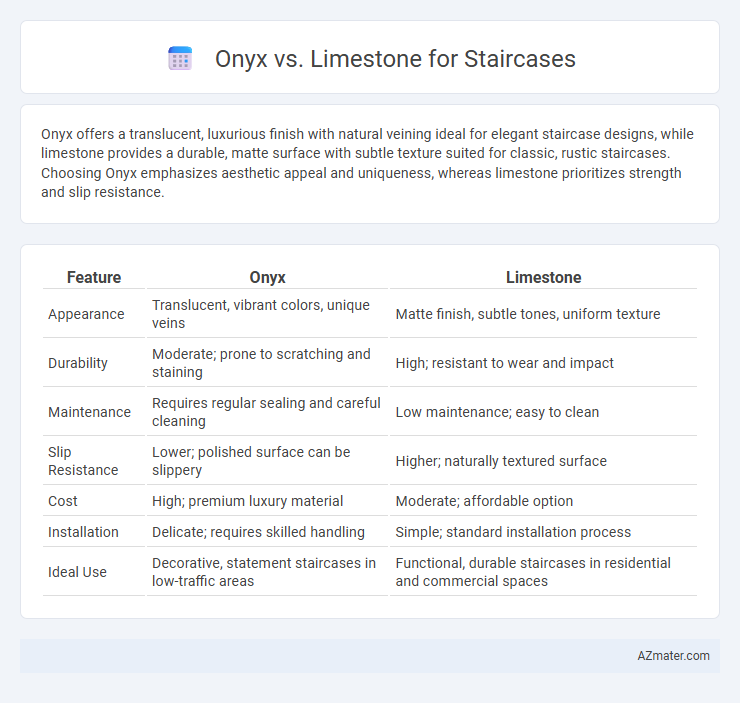Onyx offers a translucent, luxurious finish with natural veining ideal for elegant staircase designs, while limestone provides a durable, matte surface with subtle texture suited for classic, rustic staircases. Choosing Onyx emphasizes aesthetic appeal and uniqueness, whereas limestone prioritizes strength and slip resistance.
Table of Comparison
| Feature | Onyx | Limestone |
|---|---|---|
| Appearance | Translucent, vibrant colors, unique veins | Matte finish, subtle tones, uniform texture |
| Durability | Moderate; prone to scratching and staining | High; resistant to wear and impact |
| Maintenance | Requires regular sealing and careful cleaning | Low maintenance; easy to clean |
| Slip Resistance | Lower; polished surface can be slippery | Higher; naturally textured surface |
| Cost | High; premium luxury material | Moderate; affordable option |
| Installation | Delicate; requires skilled handling | Simple; standard installation process |
| Ideal Use | Decorative, statement staircases in low-traffic areas | Functional, durable staircases in residential and commercial spaces |
Introduction: Onyx vs Limestone for Staircases
Onyx offers a translucent, luxurious appearance with unique veining patterns that enhance staircase aesthetics and create a striking visual impact. Limestone provides a more subdued, classic look with durable, fine-grained texture ideal for high-traffic areas and traditional design schemes. Both materials offer distinct advantages in terms of durability and style, making the choice dependent on desired ambiance and maintenance considerations.
Material Overview: Onyx and Limestone Explained
Onyx is a translucent, crystalline form of quartz known for its striking veined patterns and high polish, making it ideal for luxurious staircase designs that emphasize elegance and visual impact. Limestone, a sedimentary rock composed primarily of calcium carbonate, offers a more muted, matte finish with natural textures that provide durability and a classic, timeless appeal for staircases. Both materials vary in hardness and maintenance needs, with onyx requiring more careful handling due to its softness compared to the relatively hard and weather-resistant limestone.
Aesthetic Appeal: Visual Differences
Onyx staircases exhibit a translucent, glossy surface with natural veining that creates a luxurious and dramatic aesthetic. Limestone features a matte, opaque finish with subtle textures and earth-toned colors, offering a more rustic and subdued visual appeal. The vibrant luminance of onyx contrasts sharply with the gentle, muted elegance of limestone, making each choice suited to distinct interior design styles.
Durability and Strength Comparison
Onyx offers a striking aesthetic with moderate durability, but it is softer and more prone to scratches and chips compared to limestone. Limestone provides superior strength and resilience, making it better suited for high-traffic areas like staircases where durability is crucial. Choosing limestone ensures long-lasting structural integrity, while onyx requires more careful maintenance to preserve its appearance.
Maintenance Requirements
Onyx staircases demand higher maintenance due to their porous nature, requiring regular sealing to prevent staining and damage from moisture. Limestone, while also porous, is generally more durable and easier to maintain with routine cleaning and occasional resealing. Both materials benefit from using pH-neutral cleaners to preserve their natural beauty and longevity.
Cost Analysis: Onyx vs Limestone
Onyx staircases typically cost between $100 to $250 per square foot due to their unique translucency and intricate veining, making them a luxury choice. Limestone, with prices ranging from $40 to $70 per square foot, offers an affordable alternative while maintaining durability and a classic aesthetic. Labor and installation expenses for onyx are higher because of its fragility and specialized handling, whereas limestone's sturdier composition reduces overall project costs.
Slip Resistance and Safety
Onyx and limestone vary significantly in slip resistance and safety for staircase applications. Onyx typically has a polished, glossy finish, which can be very slippery when wet, increasing the risk of falls without proper anti-slip treatments. Limestone generally offers better natural slip resistance due to its more textured, matte surface, making it a safer choice for stairs in high-traffic or moisture-prone areas.
Installation Process and Complexity
Onyx installation for staircases requires specialized handling due to its translucency and fragility, necessitating precise cutting and support to prevent cracking. Limestone, being denser and more robust, offers easier installation with standard tools, reducing the time and complexity for contractors. Both materials demand skilled labor, but onyx typically involves higher costs and careful preparation to maintain its aesthetic appeal during the installation process.
Environmental Impact and Sustainability
Onyx and limestone display distinct environmental impacts and sustainability profiles when used for staircases. Onyx quarrying often involves higher energy consumption and generates more waste due to its fragile, translucent nature, whereas limestone is more abundant and easier to source with less environmental disruption. Limestone's natural durability and lower energy demands in extraction and processing position it as a more sustainable option for eco-conscious staircase design.
Best Applications: Which Material Suits Your Staircase?
Onyx, with its translucent quality and vibrant color variations, is ideal for statement staircases in luxury interiors where visual impact and unique light diffusion are desired. Limestone offers durability and a matte, earthy finish, making it suitable for high-traffic staircases in both traditional and contemporary designs, especially in outdoor or rustic settings. The choice depends on whether the staircase prioritizes aesthetic elegance and light play (Onyx) or robustness and subtle texture (Limestone).

Infographic: Onyx vs Limestone for Staircase
 azmater.com
azmater.com